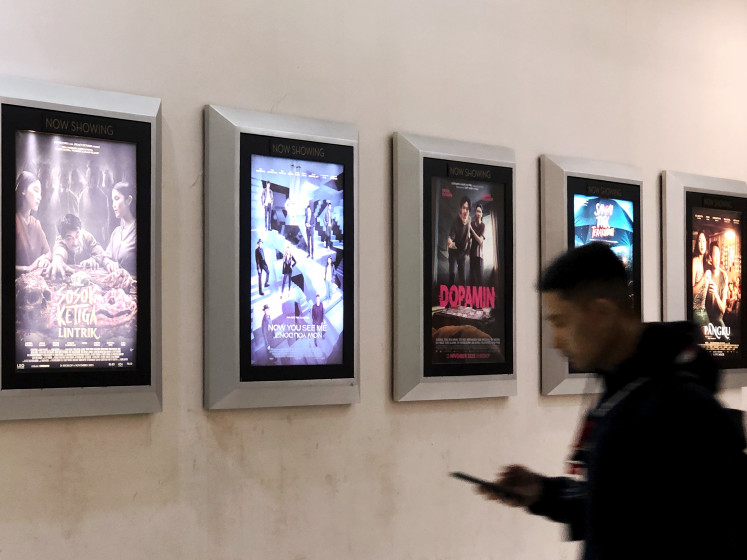Popular Reads
Top Results
Can't find what you're looking for?
View all search resultsPopular Reads
Top Results
Can't find what you're looking for?
View all search resultsRadio: A friend of yours?
I'd sit alone and watch your light My only friend through teenage nights And everything I had to know I heard it on my radio
Change text size
Gift Premium Articles
to Anyone
I'd sit alone and watch your light My only friend through teenage nights And everything I had to know I heard it on my radio . Radio what's new?
Radio, someone still loves you!
So sang Freddie Mercury, the lead singer of legendary rock band Queen, in "Radio Ga-Ga" back in the 1980s. Back then, although radio faced fierce competition from television, people still turned on and tuned in for some "quiet" and "intimate" moments.
But with MP3 players giving everyone their favorite music on demand, and pretty much anything available online today, is there anyone who still loves the radio now?
"I do," says 22-year-old Retno Dewi, laughing. "I can't even get to sleep *at night* without listening *to the radio*."
Retno claims there is a kind of personal attachment between her and the radio. Even in the morning, she says, she turns on the radio to listen to her favorite program "Putuss" on Prambors FM.
"It has long been my habit to start my day with *listening to* the radio. My radio has to be turned on while I'm getting ready to go to uni," she says.
"I can even remember the time I bought a cell phone. The first thing I asked the vendor was, *Does this type support radio?'."
Retno isn't the only one ga-ga over radio. Banking executive Bandaranaike Dewinta trusts the radio to entertain her as she sits in the car, trapped in traffic jams.
"Besides music, the radio can also provide me with the latest information," says the 25-year-old. "Like when I don't have time to read newspapers in the morning, I listen *to RRI Pro 2 FM* to find out what the headlines are that day."
Anybody out there?: The number of radio stations in Indonesia is growing, even as the number of people tuning in falls. But data show radio is still a big part of people’s lives (JP/R. Berto Wedhatama)
The radio's golden days may have passed, but if Dewinta and Retno are any indication, the "wireless" has not passed out of the hearts of everyone. Even as newer and sharper technologies battle for everyone's attention, the medium of radio has value that just can't be taken away.
Whereas the TV requires us to stay glued to the screen to enjoy its programs, the radio is less demanding, giving people the chance to multitask.
And even when people spend most of their time on the Internet, the radio can accompany the surfing, chatting and blogging.
"The radio, after all, is like a friend to everyone," says Malik Sjafei Saleh, chief commissioner of Masima Content and Channel, which owns several radio stations, including Prambors FM, Delta FM and Female FM. "People call up and are willing to share their stories on the radio. You can laugh, and don't have to act formal - just like friends.
"On the TV, you don't see or have such intimacy," he adds.
To watch the TV, Malik points out, people need to actually have a TV especially for that purpose. The same applies to the Internet - you need a computer of some description. But the radio "you can access through your gadgets *like cell phones and MP3 players* that you always take with you." Again, it's about multitasking, and the radio, Malik says, can be with you all the time - just like a good friend.
And also like friends, radio stations come with different characters, designed to appeal to people who are of a similar ilk to them.
"If you're someone who loves to get the latest updates, then you'll want a friend who can give those things to you. So you turn to radio stations like Elshinta FM," Malik says. On the other hand, "If you're into talk shows, then you'll listen to the stations that provide you with them."
In brief, he says, you look for the stations that fit you best, which isn't something you can get from the TV, which is out to please everyone.
In Indonesia, radio stations are put into one of four classes. Group A comprises stations that play music such as jazz and classical music. Group B stations are those that play pop/rock music. Radio stations that play dangdut and tarling (acoustic guitar and flute) songs are placed into Group C, while those with traditional-language songs are in Group D.
Perhaps because radio has been around for such a (relatively) long time and weathered all sorts of trends, the radio industry itself doesn't really have anything like trends, Malik says.
Radio stations do make innovations, but their main aim, after all, is to keep their character of "being a friend" for listeners.
"The way the radio changes is not a trend; it's situational," says Malik, who's also the Chairman of the Association of Private Radio Stations (PRSSNI) for Jakarta chapter.
For example, he says, during the 1998 riots, people listened to news stations like Elshinta because they needed updates about what was going on in the city, so they could be aware of any dangerous situations.
"But after that, when the situation was getting more stable during the *former president* Megawati *Soekarnoputri* era, people returned to the stations full of entertainment," Malik says. "So it's a matter of situations, not trends."
Since the reform, Indonesia has seen an increase in the number of radio stations. In 1997, for example, the Communications and Information Ministry recorded around 700 state-owned and private radio stations. By 2008, that number had grown to about 1,200, around 60 of which are in Jakarta.
But the growth in the number of radio stations, however, doesn't seem to have been matched by an equivalent growth in the number of listeners.
According to Nielsen, from January to December 2008, 12,898 people over the age of 10 in the Greater Jakarta area listened to the radio each week. The previous year, 14,424 listeners passed some of their time with the radio each week.
Not only has the number of listeners dropped, but the total time spent listening to the radio each day has also fallen.
In 2008, the average time spent each day was 2 hours 38 minutes, a decrease from 3 hours and two minutes in the previous year.
But there's also evidence that even with this decrease, the radio is still a big part of people's lives.
A Nielsen study from 2008 found that 65 percent of upper-class residents of Greater Jakarta over the age of 15 still listened to the radio. In comparison, 64 percent of them used the Internet and 97 percent watched TV.
According to the survey, called the Nielsen Upper Market Study, 56 percent from about 1,000 people surveyed listened to the radio in their cars, 46 percent listened at home and another 4 percent had their radio on at work.
So when these people were turning on, what were they tuning in to?
According to the survey, Indonesian pop music claims the highest share, with 38 percent, with Western music attracting just over 12.5 percent.
About 16 percent of people listen to the news, with 12 percent and 6.8 percent choosing talk radio and religious programs, respectively.
But whatever the program content, Malik says, every radio station shares one main formula: Playing music or programs that stay in people's minds.
"Like when they play songs, they have to play the popular ones, so listeners can recall them easily," he says. "Just the same as when they have a talk show: They have to bring up popular topics that have some attachment in the listener's mind. After all, they want people to stick to them."
Let's hope you never leave old friend
Like all good things on you we depend
So stick around cos we might miss you
When we grow tired of all this visual
You had your time, you had the power
You've yet to have your finest hour
- Queen, "Radio Ga-Ga"










